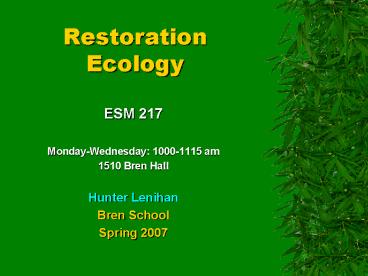Restoration Ecology - PowerPoint PPT Presentation
1 / 15
Title:
Restoration Ecology
Description:
Dr. Lisa Stratton (UCSB Biodiversity and Restoration Center) - Student project ideas ... Dr. Frank Davis Everglades restoration. Dr. Dan Reed Kelp forest ... – PowerPoint PPT presentation
Number of Views:851
Avg rating:3.0/5.0
Title: Restoration Ecology
1
Restoration Ecology
- ESM 217
- Monday-Wednesday 1000-1115 am
- 1510 Bren Hall
- Hunter Lenihan
- Bren School
- Spring 2007
2
Ecological restoration is the process of
repairing damage caused by humans to the
diversity and dynamics of indigenous ecosystems
(Society for Ecological Restoration)
What is Restoration Ecology?
3
Defined
- The discipline of scientific inquiry dealing with
the restoration of ecological ecosystems. - Simplest form removing a perturbation and
allowing natural recovery - Full restoration creating a once-again resilient
ecosystem, with the capacity to recover from
stress.
4
The process
- Scientific-based restorations follow
- 1. Explicitly stated goals
- 2. A restoration design informed by
ecological knowledge - 3. Quantitative assessment of systems responses
pre- and post-restoration data collection - 4. An adaptive process when analysis and
application of results are used to inform
subsequent efforts
5
- Ecological theory
- Concepts, predictive models and mathematical
- models to explain patterns and processes
Restoration ecology The scientific process of
developing theory to guide restoration and using
restoration to advance ecology
Benefits of linkages
Ecological restoration The practice of restoring
degraded ecological systems
6
US history of Restoration Ecology
Critical moment in conservation movement The
time has come for science to busy itself with the
earth itself. The first step is to reconstruct a
sample of what we had to begin with
Critical moment in ecological science novel
combination of agriculture and ecology which
sewed the seed that has grown into the science
and art of ecological restoration
7
Leopold understood that the value of restoration
science was two fold As an environmental
technology as a technique for basic ecological
research
Simple idea The most valuable and powerful
ways of studying something is to attempt to
reassemble it, repair it, and to adjust it so
that it works properly
Restoration as a step towards a better
relationship with and deeper understanding of the
environment and a means of testing ecological
theory and concepts
A synthesis of theory and practice
8
Ecological ideas to explore in restoration
- Overlap of theories in restoration ecology,
conservation biology, and environmental
management - Biotic interactions, recruitment, performance,
and population dynamics - Community succession and assembly
- Disturbance and species invasions
- Physical-biological coupling
- Ecosystem engineers
- Phytoremediation biomanipulation
- Restoration scaling
9
Restoration values
- What is the comparative value of undisturbed and
restored - ecosystems?
- If we succeed in completely restoring a damaged
ecosystem to a predisturbed structure, have we
recovered all the value lost through damage?
- Should we wholeheartedly embrace restoration as a
new paradigm for environmentalism or
environmental management?
- What is natural and wild?
10
Restoration practices
- What are acceptable means for achieving
restoration goals?
- How invasive should we be?
- Under what circumstances is it permissible to
cause death to achieve the goals of restoration?
- transportation of reintroduced species
- Husbandry of at-risk species
- Eradication of exotic species
- Introduction of predators
11
Course format
- Areas of focus
- Restoration of degraded ecosystems
- Restoration as a means to explore ecological
theory - Case studies
- Objectives
- Participate in discussions read
- Field research - proposal, report, oral
presentation - Review of ecological concepts essential to
restoration - Conduct field-based applied science!
12
Guest speakers to present original restoration
research
Case studies
- Dr. Lisa Stratton (UCSB Biodiversity and
Restoration Center) - Student project ideas - Dr. Carla DAntonio Plant invasions and
restoration - Dr. Tom Dunne - River restoration
- Dr. Frank Davis Everglades restoration
- Dr. Dan Reed Kelp forest recovery
13
(No Transcript)
14
Scholarship
Course work
- Ecological theory and concepts
- Theory and life history of your target ecosystem
- Synthesis of information from other courses
sources - Experimental and sampling design
- Application of scholarship
- 45 of course time dedicated to field projects
- Data analysis
- Written and oral presentation
15
A chance to explore and apply what you learned at
Bren
LETS HAVE FUN!































